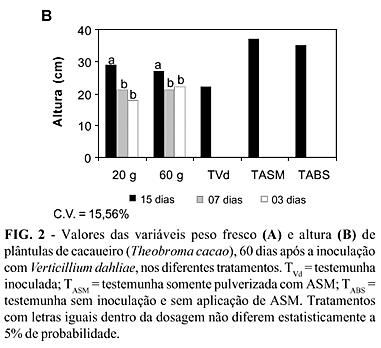Induced resistance represents a promissing strategy in the integrated management of Verticillium wilt of cocoa (Theobroma cacao), because it makes it possible to exploit susceptible cultivars with good agronomical characteristics. Great advances in this area have occurred with the use of the S-methyl ester of benzo-(1,2,3)-thiadiazol-7-carbotioic acid (acibenzolar-S-methyl, ASM). However, the efficiency of this compound depends on the time of application and dosage used. The purpose of this study was to identify the best time of application and correct dosage of ASM in the pathosystem cocoa x Verticillium dahliae. The ASM was sprayed onto the leaves of cocoa seedlings cv Theobahia, at 20 g or 60 g of active ingredient (a. i.)/100 l of water, 15, seven or three days before pathogen inoculation. The disease index at 30, 45 and 60 days after pathogen inoculation was evalueted using the area under the disease progress curve (AUDPC), and the fresh weight and height of seedlings 60 days after inoculation. The time of application had a more important influence than dosage; 15 days before inoculation was found to be the best time for application of ASM. Decreases of up to 55.4% in the disease index, increases of 10.5% in fresh weight and 35.7% in plant height were observed at a dose of 20 g a. i./ 100 l of water, when compared to control seedlings inoculated with only the pathogen, thus evidencing the efficacy of ASM as a resistance inducer in cocoa seedlings susceptible to Verticillium wilt.
Verticillium dahliae; Theobroma cacao; induced resistance; BTH






